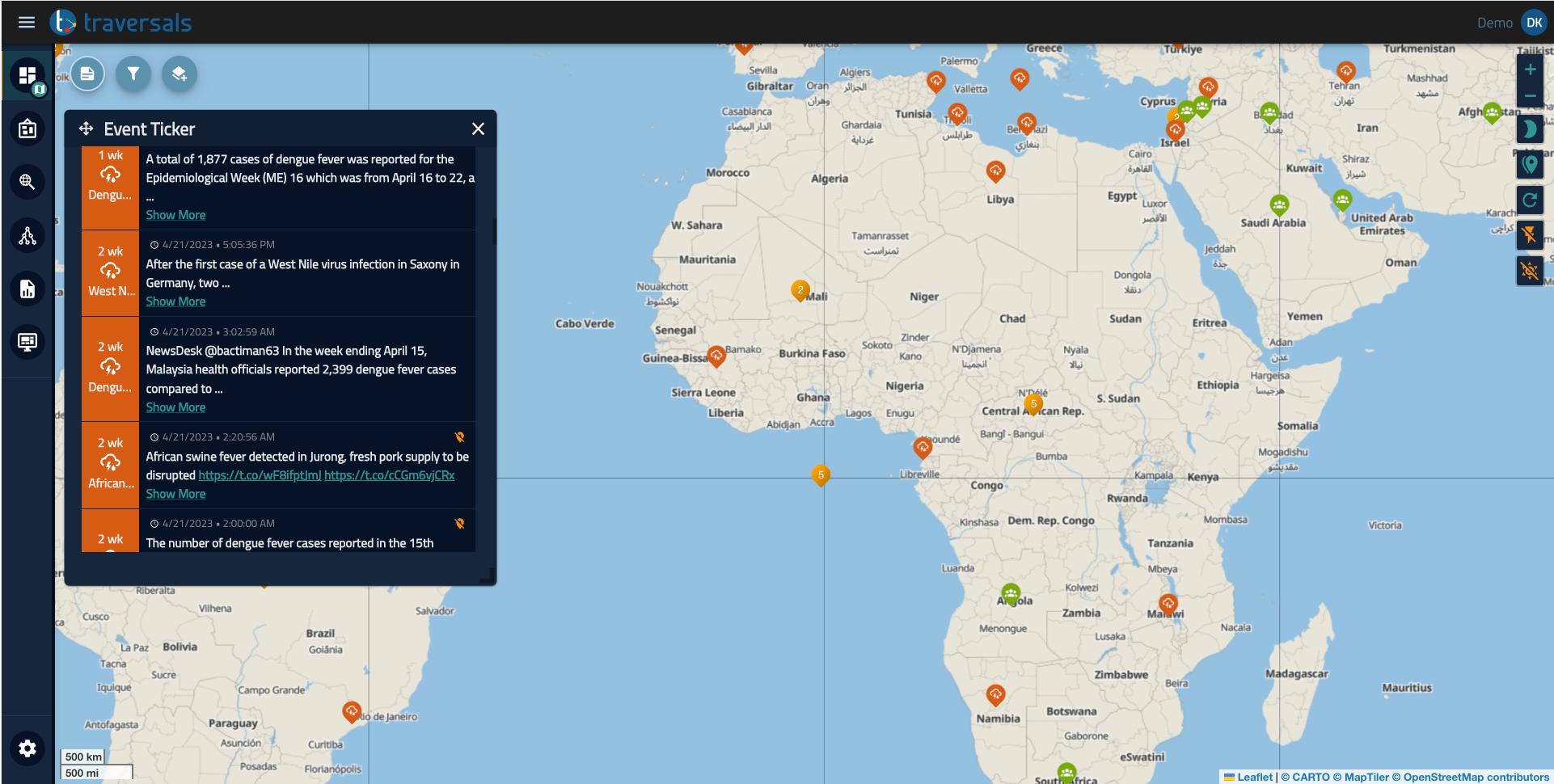MSC Innovation Night 2023: Information Superiority Based on Open Sources
Traversals announces strategic partnership with Northern Business School offering research, training and concept development. … Read More
Traversals has set up the Emerging Diseases Radar [EDR] service to detect early indicators for new disease outbreaks or to monitor ongoing pandemic developments globally. Relevant data sources are queried at regular intervals, information is collected, machine-translated, selected, categorized and enriched with structured data. The processed information is offered as a live feed and also as a corpus of historical data without dedicated further analysis. Appropriate interfaces enable the integration of the information into customers’ systems. The service can be accessed as SaaS hosted in the EU cloud with a web client or via the API.
EDR /
Introduction
Emerging infectious diseases pose a significant threat to public health and can have a severe impact on the global economy. The outbreak of the novel coronavirus (COVID-19) in late 2019 is an example of how an emerging disease can spread rapidly and have devastating consequences. Governments need an emerging diseases radar to identify and track potential outbreaks and take proactive measures to prevent their spread.
In the case of COVID-19, monitoring Chinese news and social media could have provided an early warning of the outbreak. Reports of a cluster of pneumonia cases in Wuhan, China, were initially shared on social media in late December 2019. A more comprehensive monitoring system that tracked online news, social media, and other sources could have identified the outbreak sooner, allowing for earlier intervention and containment.
An emerging diseases radar could also help governments identify potential hotspots for disease transmission, such as areas with high population density or frequent international travel. Governments can then implement measures such as travel restrictions or quarantines to prevent the spread of the disease.
Additionally, an emerging diseases radar could help identify potential treatments or vaccines for emerging diseases. By tracking research and development activities, governments can identify promising treatments and facilitate their development and distribution.
Overall, an emerging diseases radar is essential for governments to identify and respond to potential outbreaks. By leveraging data from various sources, including news and social media, governments can identify emerging diseases early, implement measures to prevent their spread and facilitate the development of treatments and vaccines.
EDR /
Core Features
[EDR] is self-learning and detects local changes in infection outbreaks and automatically adjusts multilingual information retrieval.
[EDR] includes pre-trained event detection for infectious diseases and animal diseases, which condenses the information.
[EDR] searches not only for already attributed events, but also for non-attributed anomalies (high fever population spanning,…).
[EDR] searches global sources (news, social media, blogs) in near real-time 24/7/365 and prepares found information.
[EDR] empowers your situation center analysts in the shortest possible time using an intuitive web interface or an easy-to-integrate API.
[EDR] integrates seamlessly with other solutions, contributing to a holistic epidemiological picture of the situation.
[EDR] offers automatic content-indexing, pre-processing of unstructured mass data, a broad multilingual information base and relieves analysts of routine work.

EDR /
Technical Details
Fast, secure and always up to date. The [EDR] service is constantly being improved through customer feedback. New features are implemented in the shortest possible time thanks to the modern DevSecOps architecture and improve customer deployment.
English, French, Chinese. Other optional languages, such as Spanish, German, …
AI-based event classification with categories for human/animal infectious diseases, such as COVID-19, Ebola, Marburg Virus, Zikka Virus, Monkey Pox, African Swine Feaver, …
Automated search with an interval of 12h. Shorter optional search intervals of e.g. 4h.
GDPR-compliant integration of Global News, Twitter, TikTok and Telegram. Further optional data sources, e.g. VKontakte, Reddit, Yandex, Google, …
Context-sensitive and robust geocoding of text content.
AI-based object recognition, scene identification, face recognition, multilingual optical character recognition.
Protected access to texts, images and videos using the built-in proxy system.
SaaS hosting in the EU cloud with web client or API (Application Programming Interface).
EDR /
Resources
MSC Innovation Night 2023: Information Superiority Based on Open Sources
Traversals announces strategic partnership with Northern Business School offering research, training and concept development. … Read More
Traversals Partners with OTH Regensburg
Traversals announces strategic partnership with Northern Business School offering research, training and concept development. … Read More
Traversals Partners with Northern Business School
Traversals announces strategic partnership with Northern Business School offering research, training and concept development. … Read More
The “Synergies in the Turning Point” event will take place at TechBase Regensburg on April 7, 2025. It will explore business opportunities, cooperation models, and technological innovations in the security and defense sector.
📅 Join us & register now!

Synergien in der Zeitenwende: Unternehmenskooperationen und Diversifizierungsmöglichkeiten für...
TechBase Regensburg, 10:00 - 14:00 Uhr
www.mobilitylogistics.de
Joining forces against AI-based attacks! In the BMBF joint project AI.Auto-Immune, @tu_dresden, @HAWHamburg, Alpha Strike Labs GmbH and we are working to protect the internet with AI.

TUD koordiniert Verbundprojekt "AI.Auto-Immune" zur Abwehr KI-basierter Angriffe auf das Internet
tu-dresden.de
🌍 Traversals joins the “Urban Heat Labs” pilot project. 🌡️This project leverages data fusion and artificial intelligence (#AI) to identify urban heat hotspots and develop preventive measures to mitigate heat impacts.
#UrbanHeatLabs #ArtificialIntelligence #HeatProtection